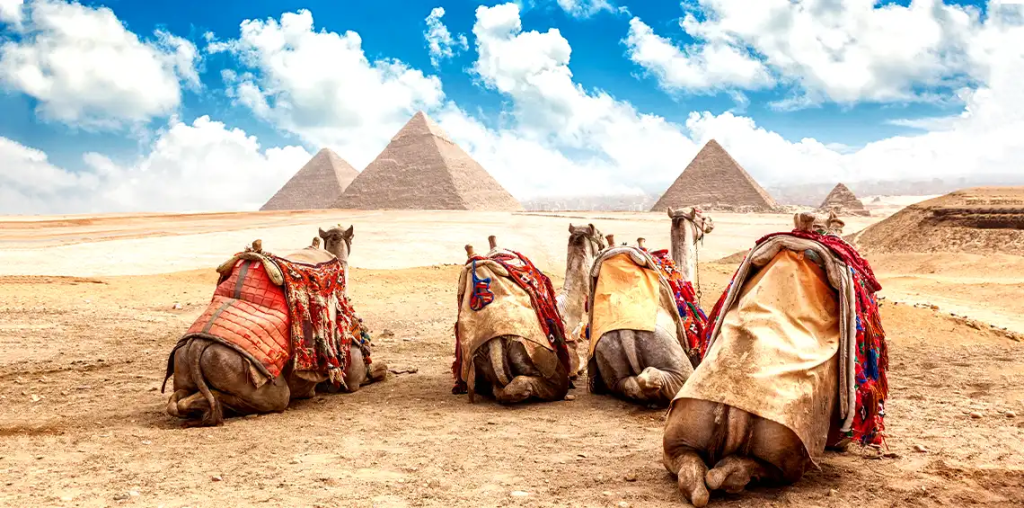
Amidst the windswept sands of Dahshur, the Black Pyramid of Amenemhat III stands as a testament to the innovative spirit and ambition of ancient Egyptian architecture. Constructed during the Middle Kingdom, this pyramid is a unique marvel that showcases Pharaoh Amenemhat III’s vision and the intriguing mysteries that surround its construction. In this comprehensive blog post, we delve into the captivating history, architectural distinctiveness, and cultural significance of the Black Pyramid of Amenemhat III.
Pharaoh Amenemhat III and His Reign: The Black Pyramid, also known as the Pyramid of Amenemhat III, was built to honor Pharaoh Amenemhat III of the Twelfth Dynasty. His reign marked a period of stability and prosperity, characterized by advancements in agriculture, arts, and architecture. The Black Pyramid is a testament to his ambition and his desire to leave a lasting legacy.
Architectural Uniqueness: The Black Pyramid stands apart from its contemporaries due to its unique construction material—dark, mudbrick blocks that have earned it the name “Black Pyramid.” Its original limestone casing has eroded over time, revealing the dark inner core. The pyramid’s base measures approximately 105 meters (344 feet) per side, with an original height of around 75 meters (246 feet). Its distinctive appearance sets it apart as a striking anomaly among Egypt’s pyramids.
Ritualistic Complex and Symbolism: The Black Pyramid’s complex includes a mortuary temple, a causeway, a valley temple, and subsidiary pyramids. While smaller in scale compared to other pyramid complexes, it reflects the architectural and ritualistic innovations of its time. The pyramid’s rituals and ceremonies were dedicated to ensuring Pharaoh Amenemhat III’s successful transition to the afterlife—a key focus in ancient Egyptian beliefs.
Legacy and Historical Intrigues: The Black Pyramid holds mysteries that continue to captivate researchers and Egyptology enthusiasts. Its unconventional design and construction materials have led to speculations about its significance and potential architectural experimentation. The complex’s smaller size and intricate features also raise questions about the shifting priorities of pyramid construction during this period.
Cultural Significance and Preservation: While the Black Pyramid may not be as widely recognized as the Great Pyramid of Giza, its significance remains undiminished. Ongoing preservation efforts ensure that this historical treasure is safeguarded for future generations. As technology advances, researchers gain new insights into its construction methods and the cultural context of its time.
A Glimpse into the Past: The Black Pyramid of Amenemhat III stands as a silent sentinel to an era of innovation and architectural exploration. It invites us to explore not only its physical dimensions but also the cultural, religious, and societal forces that shaped its creation. As we gaze upon its enigmatic form, we are transported back to a time when ancient Egyptians sought to conquer time itself through monumental structures.
Best Tours to Egypt
Unveiling the concealed beauty of ancient Egypt is an unparalleled opportunity that must not be overlooked. Carve out a moment to immerse yourself in the splendor of these awe-inspiring destinations through our meticulously tailored Egypt holidays from the UK.

4 Days Cairo and Abu Simbel Tour Package
Embark on an unforgettable 4-day tour package to Cairo and Abu Simbel, where ancient wonders and majestic temples await. Explore the iconic sites of Cairo, including the pyramids of Giza and the Egyptian Museum, before journeying to Abu Simbel to witness the breathtaking temples of Ramses II and Nefertari. With our carefully curated itinerary, knowledgeable guides, and inclusive services, this tour offers a compact yet immersive experience of Egypt’s rich history. Discover the secrets of the pharaohs, marvel at awe-inspiring architecture, and create lasting memories View Tour Details

5 Days Cairo and Alexandria Tour Package
Embark on a 5-day journey through Egypt’s most fascinating cities, Cairo and Alexandria. From the grand pyramids and ancient temples to the coastal beauty and cultural landmarks, this tour package is designed to showcase the best of both worlds. With expert guides, comfortable accommodations, and convenient transportation, you’ll have an immersive and hassle-free experience. Join us on this captivating adventure and create memories that will last a lifetime View Tour Details

6 Days Cairo, Luxor, Aswan & Abu Simbel Package
Embark on an extraordinary 6-day journey through the heart of ancient Egypt with our Cairo, Luxor, Aswan & Abu Simbel package. Begin your adventure in Cairo, where you’ll explore the iconic pyramids and delve into the treasures of the Egyptian Museum. Continue to Luxor and Aswan, where you’ll witness the grand temples along the Nile River, and conclude your tour with a visit to the awe-inspiring temples of Abu Simbel. With expert guides, comfortable accommodations, and hassle-free transportation, this package offers a comprehensive exploration of Egypt’s historic sites. Join us on this incredible journey and unlock the secrets of the pharaohs View Tour Details

7 Days Cairo, Luxor & Alexandria Tour
Experience the best of Egypt’s cultural and coastal attractions with our 7-day Cairo, Luxor & Hurghada holiday. Begin your journey in Cairo, where you’ll discover the iconic Pyramids of Giza, explore the ancient artifacts at the Egyptian Museum, and immerse yourself in the vibrant atmosphere of Egypt’s capital. Then, travel to Luxor, often referred to as the world’s greatest open-air museum, where you’ll explore magnificent temples, tombs, and archaeological sites. Finally, unwind in the idyllic beach destination of Hurghada, known for its pristine beaches and vibrant marine life View Tour Details
Related Egypt Tours Blog

Embark on an enchanting journey to the Giza Pyramids Complex, a testament to the ancient wonders of Egypt. Explore the iconic pyramids, unravel the mysteries of the Sphinx, and immerse yourself in the rich history of this UNESCO World Heritage Site. Join our guided tour to experience the awe-inspiring architecture, captivating legends, and breathtaking views of the Giza Plateau View Tour Details

The Saqqara Step Pyramid is a cornerstone of ancient Egyptian architecture, marking the transition from mastaba tombs to monumental pyramids. This guided tour takes you to Saqqara’s historical complex, where you’ll not only encounter the Step Pyramid but also explore fascinating tombs, chapels, and ancient structures View Tour Details

The Great Sphinx is an iconic masterpiece that has fascinated travelers for millennia. As you approach this enigmatic creature, you’ll feel the weight of history and the sense of wonder it evokes. Our expert guides will lead you through its mysteries and offer insights into the Sphinx’s role in ancient Egyptian culture View Tour Details
Black Pyramid of Amenemhat III FAQs
- What is the Black Pyramid of Amenemhat III? The Black Pyramid of Amenemhat III is an ancient Egyptian pyramid located in Dahshur, near Cairo. It is the burial place of Pharaoh Amenemhat III, a ruler of the 12th Dynasty during the Middle Kingdom.
- Who was Amenemhat III? Amenemhat III, also known as Pharaoh Amenemhet III, was a significant ruler of ancient Egypt during the 12th Dynasty. He is known for his long and prosperous reign and contributions to architecture and engineering.
- When was the Black Pyramid of Amenemhat III built? The Black Pyramid of Amenemhat III was built around 1860-1814 BCE during the Middle Kingdom period of ancient Egypt.
- Why is it called the Black Pyramid? The Black Pyramid gets its name from the dark, blackish stone used in its construction. This stone is not typical of other pyramids, which are mostly built using limestone.
- What is the significance of the Black Pyramid of Amenemhat III? The Black Pyramid is significant for its unique architectural style, the use of black stone, and its location in the Dahshur necropolis.
- What are the dimensions of the Black Pyramid of Amenemhat III? The Black Pyramid has a base measuring approximately 105 meters (344 feet) on each side and an original estimated height of around 75 meters (246 feet).
- Is the Black Pyramid of Amenemhat III open to visitors? Yes, the Black Pyramid is open to visitors as part of the Dahshur archaeological site. Visitors can explore the exterior of the pyramid and its surroundings.
- Can visitors enter the interior of the Black Pyramid of Amenemhat III? As of my last update in September 2021, visitors are not commonly allowed to enter the interior of the Black Pyramid. However, conditions might vary, so it’s best to check with authorities or tour guides for the latest information.
- What can visitors see around the Black Pyramid of Amenemhat III? Visitors to the Black Pyramid can explore the exterior of the pyramid, its surrounding area in Dahshur, and other nearby pyramids and structures.
- What makes the Black Pyramid unique in terms of its construction materials? The Black Pyramid’s use of black stone is unusual among Egyptian pyramids, and it stands out visually due to its distinct appearance.
- Are there any legends or myths associated with the Black Pyramid of Amenemhat III? While the Black Pyramid might not have as many legends or myths as some other pyramids, its historical and architectural significance contributes to the broader understanding of ancient Egypt.
- What is the significance of the Black Pyramid’s location in Dahshur? The Black Pyramid’s location in Dahshur is significant as it showcases the expansion of pyramid-building efforts beyond the Giza plateau and Saqqara during the Middle Kingdom.
- What is the entrance to the Black Pyramid of Amenemhat III like? The Black Pyramid has a relatively simple entrance on its north face that leads to the internal passages and chambers of the pyramid.
- What can visitors learn from the Black Pyramid of Amenemhat III? The Black Pyramid offers insights into ancient Egyptian architectural choices, the use of different materials, and the evolution of pyramid-building techniques during the Middle Kingdom.
- Are there any ongoing research or restoration efforts at the Black Pyramid of Amenemhat III? Ongoing research and restoration efforts are likely conducted to better understand the pyramid’s construction, history, and significance and to ensure its preservation.
- Can visitors climb the Black Pyramid of Amenemhat III? Climbing the Black Pyramid might not be allowed due to preservation and safety concerns. However, visitors can still explore the complex and its surroundings.
- What are the burial chambers inside the Black Pyramid used for? The burial chamber of the Black Pyramid was intended to house Amenemhat III’s body, offerings, and funerary items, according to ancient Egyptian beliefs about the afterlife.
- Can I take photographs of the Black Pyramid of Amenemhat III? Photography regulations might vary, but in general, taking photographs around the Black Pyramid for personal use could be allowed. Always follow local guidelines.
- What should I keep in mind when visiting the Black Pyramid of Amenemhat III? When visiting the Black Pyramid, respect the historical site, adhere to local regulations, and appreciate the opportunity to explore a pyramid with unique construction materials and historical significance.
- How does the Black Pyramid contribute to our understanding of the Middle Kingdom? The Black Pyramid provides insight into the architectural and engineering achievements of the Middle Kingdom, as well as the funerary practices and beliefs of that era. Its use of black stone also sets it apart as a unique monument in the ancient Egyptian landscape.

